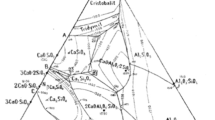Abstract
A simple treatment of chemical equilibrium is given, based on Boltzmann’s distribution law. The results are compared with those obtained by using thermodynamics.
Similar content being viewed by others
Avoid common mistakes on your manuscript.
Introduction
Chemical equilibria are usually treated by using thermodynamics or statistical mechanics. An alternative is to use Boltzmann’s distribution law (Guggenheim 1963; Nelson 1986, 1995). This has the advantage of being very much simpler, and making the treatment of chemical equilibrium consistent with that of other topics where Boltzmann’s law is used (reaction kinetics, spectroscopy, magnetochemistry, etc.). Here I apply the law to a range of chemical equilibria, and compare the results with those obtained by thermodynamics.
This approach takes Boltzmann’s law as a law of nature. The law can be demonstrated by measuring the distribution of colloidal particles in a gravitational field, as described by Slabaugh (1965).Footnote 1
Reactions in gases
Consider a pure gas, contained in a closed vessel, in thermal equilibrium with its surroundings. Suppose that, between collisions, each molecule moves independently of the others, and has a discrete set of motions. Then, according to Boltzmann’s law, the average number of molecules with a particular motion, i, over time is given by
where N is the total number of molecules, \({\upvarepsilon }_{{\rm{i}}}\) is the energy of a molecule with motion i, \({\upvarepsilon }_{0}\) is the lowest energy a molecule can have, k is the Boltzmann constant, T is the absolute temperature, and q is the partition function
This function ensures that \(\sum\nolimits_{{\rm{i}}} {N_{{\rm{i}}} } = N\). Equation (1) holds as long as the values of Ni are sufficiently low for the distribution not to be affected by molecules with the same motion (as in Bose–Einstein statistics) or by molecules resisting this (Fermi–Dirac statistics). This condition is usually met (Guggenheim 1963: Chap. 13).
Isomerizations
These are the simplest reactions to treat, since isomers can be regarded as different states of the same molecule. Consider the equilibrium
with the states available to A or B as shown schematically in Fig. 1a. From Eq. (1) the number of molecules of type A at equilibrium is given by
where ‘a’ labels states corresponding to form A. Similarly,
where \(\Delta \varepsilon_{0}\) = \(\varepsilon_{{\rm{0,B}}} - \varepsilon_{{0,{\rm{A}}}}\). The equilibrium constant of reaction (3) is therefore given by
a States available to two isomers A and B (schematic). The sequences continue indefinitely upwards. b Boltzmann distribution of molecules over the states shown in a at T = 2 \(\Delta {\upvarepsilon }_{0}\)/k (open bars, A; solid bars, B). The proportion of molecules in form A is 26% and in form B, 74%
The value of K is thus determined by two factors: the difference in energy, \(\Delta {\upvarepsilon }_{0}\), and the ratio of the partition functions, \(q_{{\rm{B}}}\)/\(q_{{\rm{A}}}\). Figure 1b shows how \(N_{{\rm{B}}}\) can be greater than \(N_{{\rm{A}}}\) even though \({\upvarepsilon }_{{0,{\rm{A}}}}\) is lower than \({\upvarepsilon }_{{\rm{0,B}}}\) (Davies 1972: Chap. 4).
Dissociations
These are representative of more complicated reactions. Consider the equilibrium
Now, instead of having a molecule existing in two different states, as in the previous section, we have a pair of radicals existing in two different states, PQ and P + Q. Equation (1) gives
Here \(N_{{\rm{P + Q}}}\) represents the number of pairs of radicals in P + Q states and \(q_{{\rm{P + Q}}}\) the partition function over such states. These are given respectively by \(N_{{\rm{P}}} N_{{\rm{Q}}}\) and (since \({\rm{e}}^{x + y}\) = \({\rm{e}}^{x} {\rm{e}}^{y}\)) \(q_{{\rm{P}}} q_{{\rm{Q}}}\). Hence
Equilibrium constants in the gas phase are usually expressed in terms of partial pressures, defined by
where n represents chemical amount and p total pressure. Thus for reaction (7) at low pressures
From Eq. (9) this is given by
Since the molecules are moving independently of each other, this can be written
where \(r_{{\rm{X}}}\) is the partition function per molecule
and \(r_{{\rm{X}}}^{*}\) is the value of this for pure X at the pressure p.Footnote 2 If Eq. (13) is evaluated at standard pressure, \(p^{\Theta }\), this gives the standard equilibrium constant:
Relation to thermodynamic treatment
By taking logarithms and multiplying through by the Avogadro constant (L), Eq. (15) can be written
where R is the gas constant (Lk), \(\Delta U_{{\rm{m}}}^{\Theta } \left( 0 \right)\) the standard molar internal energy of reaction at T = 0, and \(X_{{\rm{m}}}\) = R ln r. Comparing this equation with the corresponding thermodynamic equation
(H = enthalpy, S = entropy) identifies X as
where G is the Gibbs function (H ‒ TS).
For an ideal gas, U(0) = H(0). In this case,
where Φ(T, 0) is the Giauque function. Values of \({\Phi }_{{\rm{m}}}^{\Theta }\)(T, 0) are tabulated by Lewis et al. (1961: Tables A7-7 to A7-10).
Reactions involving liquids or solids
Equilibria involving liquids or solids cannot be treated rigorously by the above method because molecules are no longer independent. We can, however, treat them approximately by using simple models.
Model for liquids
Liquids are complicated. However, at temperatures well below the critical temperature, the essential features of equilibria involving liquids can be derived by supposing that a liquid has a lattice-like structure, with each molecule undergoing vibrational motion around a fixed position, and from time to time exchanging positions with an adjacent molecule (Guggenheim 1952: Sect. 2.05). On this model, the partition function for a molecule X in a liquid may be written
where \(N_{{\upsigma }}\) is the number of sites, \(q_{X@\sigma }\) is the partition function of X in the average environment experienced by X at a site, and \(N_{{{\rm{total}}}}\) is the total number of molecules of all kinds in the liquid. For a pure liquid, Eqs. (14) and (20) give
Liquid–gas equilibria
Consider the equilibrium between a liquid and its vapour:
This can be treated as an isomerization, with the states available to a molecule as shown schematically in Fig. 2. Application of Boltzmann’s law to this system gives, from Eq. (20),
States available to a molecule when a liquid is in equilibrium with its vapour (schematic). The liquid is assumed to have a lattice-like structure. The degeneracy of the levels for the liquid is equal to the number of molecules in this state. A similar diagram holds for a solid in equilibrium with its vapour
Hence, from Eq. (21),
Now Eq. (13) indicates that, for a pure ideal gas, r is inversely proportional to p (otherwise \(K_{p}\) would vary with p). This means that
From this and Eqs. (14) and (24), the vapour pressure of the liquid is therefore given by
The second equality can be written because the energy levels of condensed phases are relatively insensitive to changes in pressure. Equation (26) can be cast in the same form as Eq. (16). Note that p is independent of the quantity of liquid, as is observed.
Equilibria in solution
Consider the equilibrium
in solvent S. Application of Boltzmann’s law to this gives Eq. (9). Substitution of Eq. (20) into this givess
where x represents mole fraction (\(n_{{\rm{X}}}\)/\(n_{{{\rm{total}}}}\) = \(N_{{\rm{X}}}\)/\(N_{{{\rm{total}}}}\)) and \(K_{x}\) = K/\(N_{{{\rm{total}}}}\).
In general, the average environment of X, and thus the values of \(\varepsilon_{{0,{\rm{X}}}}\) and \(q_{X@\sigma }\), will depend on the composition of the solution. The only circumstances in which this will not be so are: (i) in ‘ideal’ solutions, where the different molecules making up the solution are sufficiently similar as to produce the same environment whatever their proportions; and (ii) in very dilute solutions, where the immediate environment of a solute molecule consists exclusively of solvent molecules.
Ideal solutions
In this case, \(\varepsilon_{{0,{\rm{X}}}}\) and \(q_{{{\rm{X}}@\sigma }}\) can be set at their values for pure X, when
At \(p\) = \(p^{\Theta }\), this is equal to \(K^{\Theta }\) and gives Eq. (16).
Dilute solutions
Equilibrium constants for reactions in dilute solution are usually expressed in terms of molality, defined byFootnote 3
where \(m_{{\rm{S}}}\) is the mass, and \(M_{{\rm{S}}}\) the molar mass, of solvent S. Thus for reaction (27) in dilute solution
From Eqs. (14), (20), (28), and (30), this is given byFootnote 4
where \(r_{{\rm{X}}}^{ \circ }\) is the value of \(r_{{\rm{X}}}\) at \(b_{{\rm{X}}}\) = \(b^{ \circ }\) = 1 mol kg‒1 (or better, the value \(r_{{\rm{X}}}\) would have at \(b_{{\rm{X}}}\) = \(b^{ \circ }\) if X had the same environment at this concentration as it has in dilute solution). At \(p\) = \(p^{\Theta }\), this again gives Eq. (16).
Reactions involving solids
These can be treated by assuming that the molecules in a crystal vibrate independently of each other. This corresponds to the Einstein model of a crystal (see, e.g., McGlashan 1979: Sect. 14.13). While this is inferior to the Debye model at low temperatures, it is almost as good at higher temperatures, at which most reactions involving solids occur.
The prototype of solid‒gas equilibria is the equilibrium between a crystalline solid and its vapour:
This can be treated in the same way as equilibrium (22). This is because the molecules in the crystal are continually changing places with molecules in the gas, so that each molecule can occupy any of the sites on the crystal. Application of Boltzmann’s law accordingly gives
where \(q_{{\upsigma }}\) is the partition function for a molecule at a site in the crystal. This can be developed in the same way as Eq. (23).
Other equilibria involving solids can be treated by the same methods, leading again to Eq. (16).
Notes
What Slabaugh calls ‘Perrin’s law’ is based on Boltzmann’s. His experiment needs to be carried out on a hot stage to determine the temperature-dependence.
For pure X to have a pressure p in the reaction vessel, there would need to be \({N}_{\rm{total}}\) molecules of it present. Hence \(r_{{\rm{X}}}^{*} = {{q_{{\rm{X}}} } \mathord{\left/ {\vphantom {{q_{{\rm{X}}} } {N_{{{\rm{total}}}} }}} \right. \kern-\nulldelimiterspace} {N_{{{\rm{total}}}} }}\). Substitution of this into Eq. (12) gives Eq. (13).
I have used the symbol b instead of the usual m to avoid confusion with the symbol for mass.
References
Davies, W.G.: Introduction to Chemical Thermodynamics. Saunders, Philadelphia (1972)
Guggenheim, E.A.: Mixtures. Oxford University Press, Oxford (1952)
Guggenheim, E.A.: Boltzmann’s Distribution Law, 3rd edn. North-Holland, Amsterdam (1963)
Lewis, G.N., Randall, M., Pitzer, K.S., Brewer, L.: Thermodynamics, 2nd edn. McGraw-Hill, New York (1961)
McGlashan, M.L.: Chemical Thermodynamics, Academic Press, London (1979)
Nelson, P.G.: Treatment of chemical equilibrium without using thermodynamics or statistical mechanics. J. Chem. Educ. 63, 852–853 (1986)
Nelson, P.G.: Equilibria made easy. Educ. Chem. 32, 135–137 (1995)
Slabaugh, W.H.: Determination of Avogadro’s number by Perrin’s law. J. Chem. Educ. 42, 471–472 (1965)
Author information
Authors and Affiliations
Corresponding author
Additional information
Publisher's Note
Springer Nature remains neutral with regard to jurisdictional claims in published maps and institutional affiliations.
Rights and permissions
Open Access This article is licensed under a Creative Commons Attribution 4.0 International License, which permits use, sharing, adaptation, distribution and reproduction in any medium or format, as long as you give appropriate credit to the original author(s) and the source, provide a link to the Creative Commons licence, and indicate if changes were made. The images or other third party material in this article are included in the article's Creative Commons licence, unless indicated otherwise in a credit line to the material. If material is not included in the article's Creative Commons licence and your intended use is not permitted by statutory regulation or exceeds the permitted use, you will need to obtain permission directly from the copyright holder. To view a copy of this licence, visit http://creativecommons.org/licenses/by/4.0/.
About this article
Cite this article
Nelson, P.G. A simple treatment of chemical equilibrium. Found Chem 23, 397–405 (2021). https://doi.org/10.1007/s10698-021-09404-9
Accepted:
Published:
Issue Date:
DOI: https://doi.org/10.1007/s10698-021-09404-9






